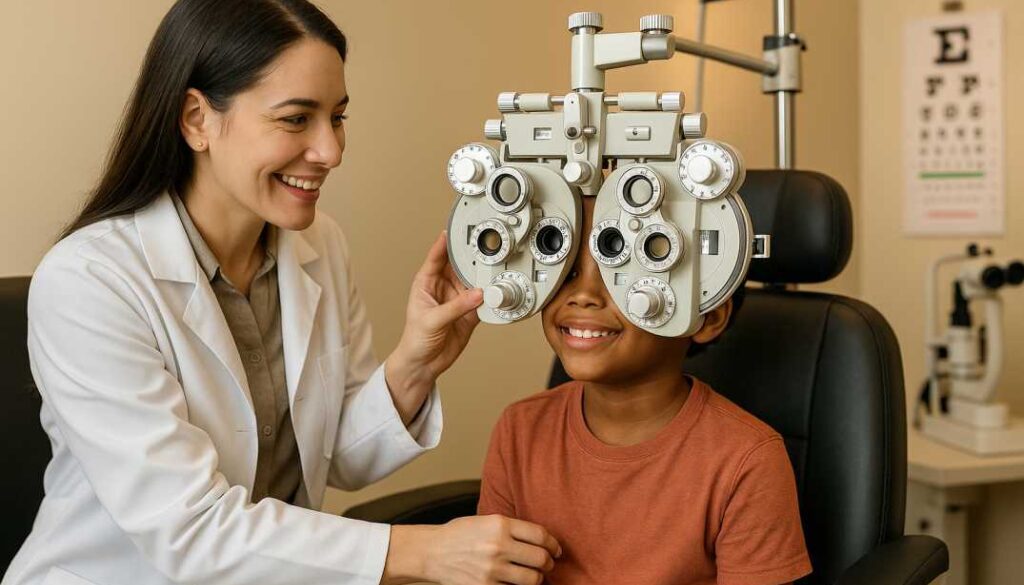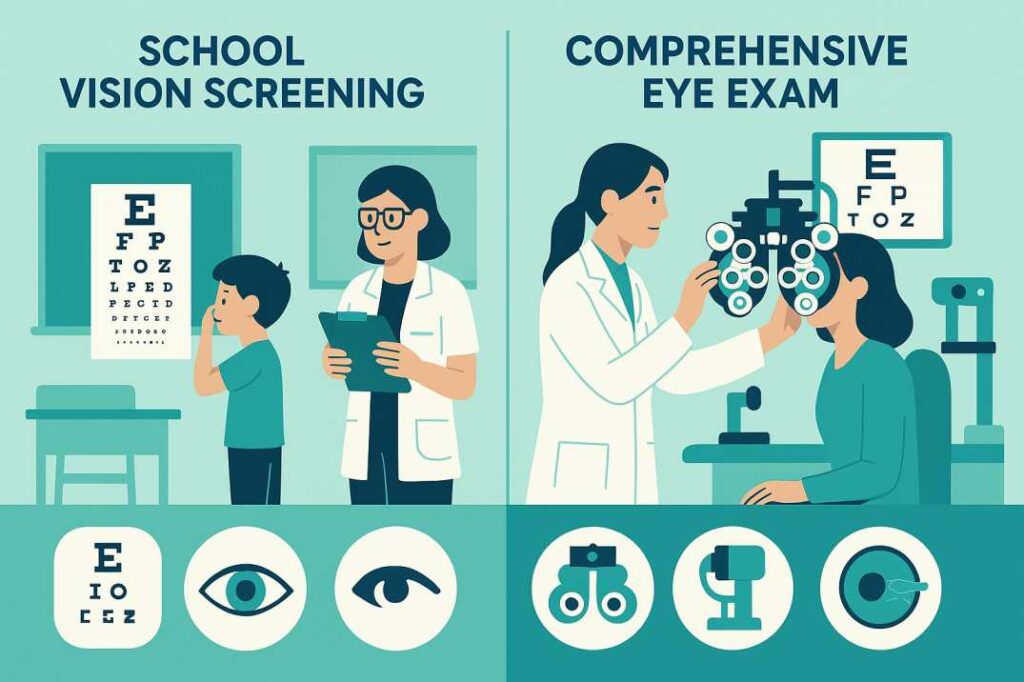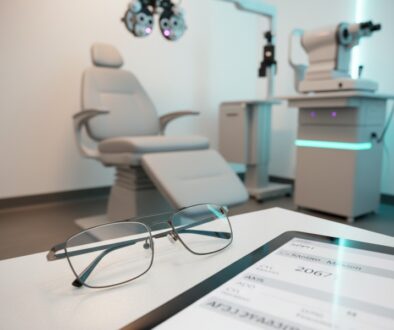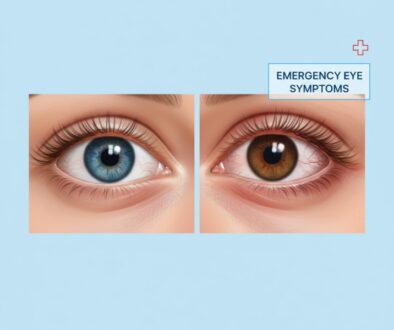School Vision Screening vs Eye Exam: The Critical Difference
Bottom Line Up Front: School vision screenings catch only the most obvious vision problems, missing up to 75% of children with vision issues that can impact learning. Comprehensive eye exams by eye care professionals provide complete vision and eye health evaluations that are essential for your child’s academic success and lifelong eye health.
Why Every Parent Needs to Know This Difference
As your child prepares for another school year, you’ve likely received that familiar notification about school vision screenings. While these screenings serve an important purpose, many parents mistakenly believe they provide the same level of care as a comprehensive eye exam. Understanding this crucial difference could mean the difference between detecting vision problems early and missing conditions that affect your child’s learning and development. At West Broward Eyecare Associates, we help families navigate these important distinctions to ensure optimal eye health for children throughout our community.
What Are School Vision Screenings?
School vision screenings are brief assessments, typically lasting just a few minutes, designed to identify children who may need further evaluation. These screenings serve as a preliminary filter to flag students with obvious vision problems.
What School Vision Screenings Include:
- Distance visual acuity testing using an eye chart (usually the Snellen chart)
- Basic eye alignment checks to detect obvious eye turns
- Simple color vision testing (in some states)
- Brief assessment for obvious refractive errors like severe nearsightedness
The Limitations Parents Must Understand
According to current research from the American Optometric Association and multiple health organizations, school vision screenings miss up to 75% of children with vision problems. Additionally, vision screenings provide less than 4% of the information generated during a comprehensive eye exam.
Why screenings fall short:
- Limited scope: The Snellen chart used in most screenings is a 150-year-old test that only measures distance vision acuity
- Untrained personnel: Many screenings are performed by volunteers or school staff without specialized vision training
- Inadequate testing environment: Screenings often occur in classrooms with poor lighting and improperly maintained equipment
- Missing near vision problems: Most screenings don’t test the close-up vision skills essential for reading and computer work
What Are Comprehensive Eye Exams?
A comprehensive eye exam is a thorough evaluation performed by a licensed optometrist or ophthalmologist using specialized equipment and clinical expertise. These exams provide over 96% more information than basic vision screenings.
Complete Assessment Includes:
Vision Testing:
- Distance and near visual acuity
- Refraction testing for precise prescription needs
- Peripheral (side) vision testing
- Color vision assessment
- Depth perception evaluation
Eye Health Examination:
- Internal eye structure evaluation
- Retinal examination
- Optic nerve assessment
- Eye pressure measurement (glaucoma screening)
- Pupil response testing
Visual Skills Assessment:
- Eye movement and tracking abilities
- Focusing flexibility
- Eye teaming and coordination
- Convergence and accommodation testing
Medical History Review:
- Family history of eye conditions
- Overall health assessment
- Developmental considerations
- Academic performance correlation
Key Differences That Matter for Your Child
Scope of Detection
School Vision Screenings:
- Detect severe myopia (nearsightedness)
- Identify obvious eye turns or lazy eye
- Screen for basic visual acuity problems
- Detect serious eye conditions like glaucoma, cataracts, and macular degeneration before symptoms appear
- Identify subtle learning-related vision problems
- Assess eye health and development
- Evaluate visual skills needed for academic success
Professional Expertise
School Screenings: Often conducted by volunteers, nurses, or school staff with basic training
Comprehensive Exams: Performed by licensed eye care professionals with specialized education and ongoing training in children’s vision
Equipment and Environment
School Screenings: Basic charts and portable equipment in variable lighting conditions
Comprehensive Exams: Advanced diagnostic equipment in controlled clinical environments designed for accurate testing
Why Your Child Needs Both – But Not As Equals
While school vision screenings serve as a valuable safety net, they should never replace comprehensive eye exams. Think of screenings as a smoke detector – useful for obvious problems but not a substitute for fire prevention and safety planning.
The Academic Connection
Research indicates that 80% of learning is based on processing visual information. When children struggle academically, undiagnosed vision problems are often overlooked causes. The National Parent-Teacher Association reports that over 10 million children in the U.S. have vision problems that can impact their learning success.
Common Vision Problems Missed by School Screenings
- Convergence insufficiency: Difficulty focusing both eyes together for reading
- Accommodative disorders: Problems with focusing flexibility when switching between distant and near objects
- Eye movement disorders: Difficulty tracking across lines of text
- Subtle refractive errors: Minor prescription needs that still impact performance
- Early eye diseases: Conditions with no obvious symptoms in the early stages
When to Schedule Comprehensive Eye Exams
Recommended Schedule by Age:
Infants (6-12 months): First comprehensive baseline exam to ensure proper eye development
Preschoolers (3-5 years): Critical period for detecting amblyopia and other conditions that could cause permanent vision loss
School-age children: Annual comprehensive exams starting before first grade and continuing throughout the school years
Children with risk factors: More frequent exams based on professional recommendations
Red Flags That Warrant Immediate Attention:
- Squinting or closing one eye
- Sitting very close to the TV or books
- Frequent headaches after reading
- Difficulty concentrating on visual tasks
- Avoiding reading or homework
- Poor academic performance despite intelligence
- Complaints of blurred or double vision
- Eye rubbing or fatigue during visual activities
The Science Behind Early Detection
Recent research underscores the importance of comprehensive eye care for children:
Study #1: Vision Screening Effectiveness
A 2024 comprehensive review published in Cureus found marked variation in screening methods across states, with most programs missing significant vision problems that could be detected through comprehensive examinations. The study emphasized the need for evidence-based criteria and professional follow-up.
Study #2: Academic Performance Impact
A 2025 systematic review in the British Journal of Ophthalmology demonstrated clear links between improved vision correction and educational outcomes, aligning with global education goals. Children who received proper vision care showed measurable improvements in reading and academic performance.
Study #3: Early Intervention Benefits
Research published in 2025 tracking vision changes post-COVID found increasing rates of vision problems in young children, highlighting the critical importance of early detection and intervention. The study noted that delayed care during the pandemic led to more severe vision problems requiring intensive treatment.
Making the Right Choice for Your Child
Understanding Insurance and Accessibility
Many insurance plans, including Medicaid, cover comprehensive pediatric eye exams. The investment in your child’s vision health pays dividends in academic success, sports performance, and overall quality of life.
Questions to Ask Your Eye Care Provider:
- What specific visual skills will you assess during my child’s exam?
- How do you test for learning-related vision problems?
- What follow-up care might be needed if problems are detected?
- How often should my child have comprehensive exams?
- What signs should I watch for between visits?
Taking Action: Your Next Steps
If Your Child Passed a School Vision Screening:
Don’t assume their vision is perfect. Even children who pass school screenings should have comprehensive eye exams, as 25% of school children have vision problems that won’t be detected by basic screenings.
If Your Child Failed a School Vision Screening:
Schedule a comprehensive eye exam promptly. The screening has identified a potential problem that needs professional evaluation and potential treatment.
For All Parents:
Make comprehensive eye exams part of your child’s regular healthcare routine, just like dental checkups and pediatric visits.
Special Considerations for West Broward Families
Local Factors Affecting Children’s Vision:
Increased Screen Time: With digital learning becoming more prevalent, children are spending more time on devices, potentially increasing their risk for myopia and digital eye strain.
Outdoor Activity Balance: Florida’s year-round sunshine provides excellent opportunities for outdoor activities, which research shows can help prevent myopia progression.
Hurricane Preparedness: Having a backup pair of glasses or contacts is essential for children who need vision correction, especially during hurricane season when regular care might be disrupted.
Cultural Considerations:
Our diverse West Broward community includes families from various cultural backgrounds. Some cultures may have different approaches to eye care, but comprehensive eye exams are universally important for children’s development and success.
The Investment in Your Child’s Future
Comprehensive eye exams are not just about seeing clearly – they’re about giving your child every opportunity to succeed. When vision problems go undetected, children may:
- Struggle academically despite their intelligence
- Develop behavioral issues from frustration
- Miss out on sports and recreational activities
- Experience decreased self-confidence
- Face long-term vision problems that could have been prevented
Additional Resources and References
For parents seeking more information about children’s vision health and the differences between screenings and comprehensive exams, these authoritative sources provide valuable insights:
1. American Optometric Association – Children’s Vision Guidelines
Source: American Optometric Association Comprehensive Pediatric Eye and Vision Examination Guidelines
The AOA provides evidence-based clinical practice guidelines for comprehensive pediatric eye examinations, including recommended examination schedules and the limitations of vision screenings. This resource confirms that school vision screenings miss up to 75% of children with vision problems and provide less than 4% of the information available through comprehensive exams.
2. Centers for Disease Control and Prevention – Vision Health Data
Source: CDC Vision Testing Among Children Aged 3–5 Years Data Brief
Recent CDC surveillance data show that only 63.5% of children aged 3-5 years had received vision testing by a health professional as of 2016-2017. This government source highlights significant gaps in pediatric eye care access and the importance of comprehensive professional examinations beyond basic screenings.
3. University of Utah Health – School Screening Limitations Research
Source: Kids’ Eye and Vision Problems: What School Screenings Might Miss
Current research from 2025 confirms that one in four school-age children has a vision disorder, yet school vision screenings continue to miss up to 75% of children with vision problems. This academic medical center source emphasizes how undetected vision issues can be misdiagnosed as ADHD, dyslexia, or behavioral problems.
Conclusion: See the Bigger Picture
School vision screenings and comprehensive eye exams both play important roles in protecting your child’s vision, but they serve different purposes. While screenings offer a basic safety net, comprehensive eye exams provide the thorough evaluation your child needs for optimal visual development and academic success.
As we move forward in an increasingly visual world, with digital learning and screen-based activities becoming the norm, comprehensive eye care for children has never been more important. Don’t leave your child’s vision to chance – the difference between a screening and a comprehensive exam could be the difference between struggling in school and reaching their full potential.
Take Action Today: Schedule your child’s comprehensive eye exam with a qualified eye care professional in your area. Your child’s future success may depend on the clarity of their vision today.
This article is for educational purposes only and should not replace professional medical advice. Always consult with a qualified eye care professional for your child’s specific vision needs.
FAQs
-
School vision screenings are basic tests conducted by non-medical staff to identify children who may need further evaluation. Comprehensive eye exams are thorough medical evaluations performed by optometrists or ophthalmologists.





